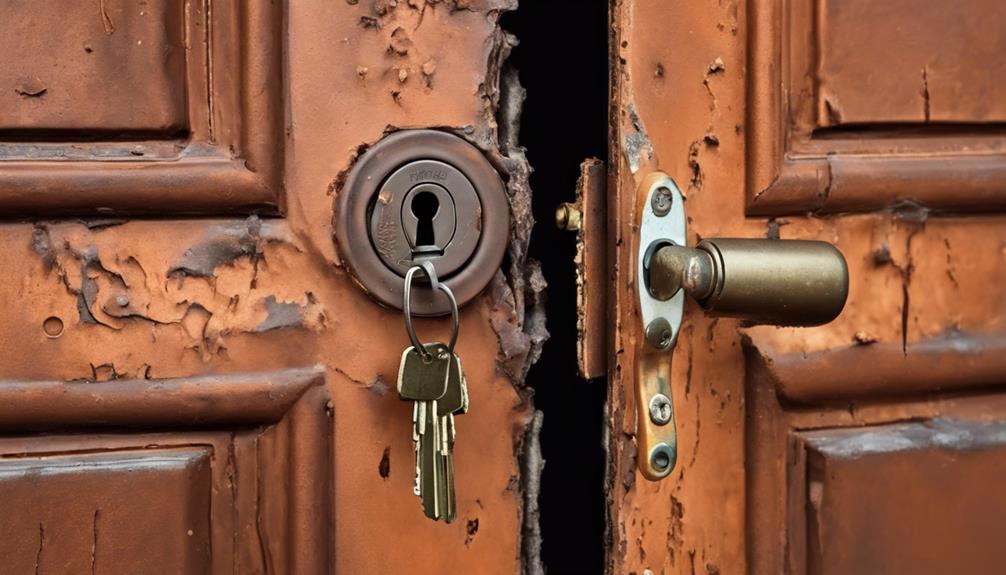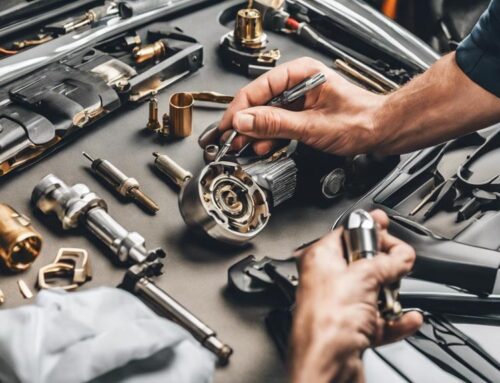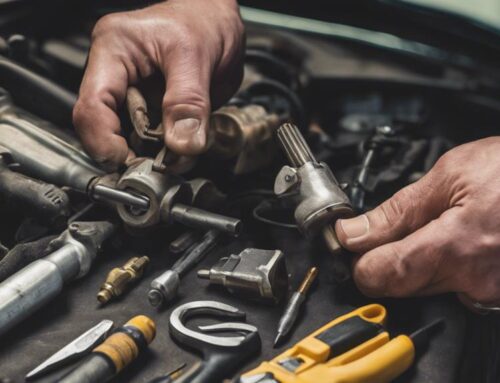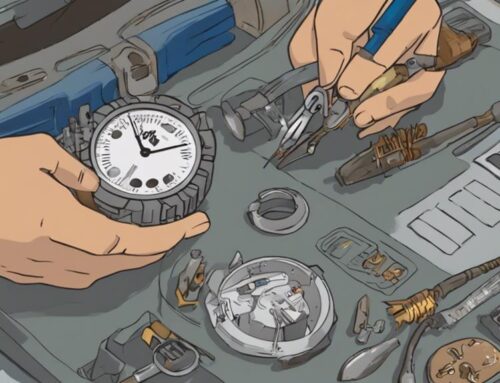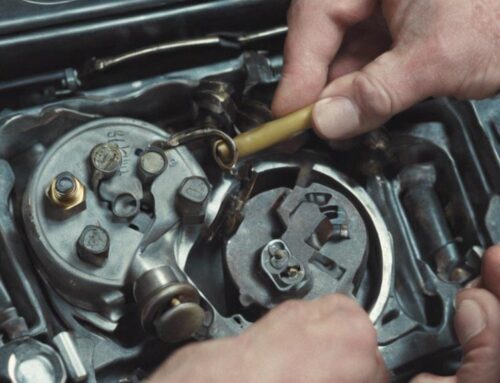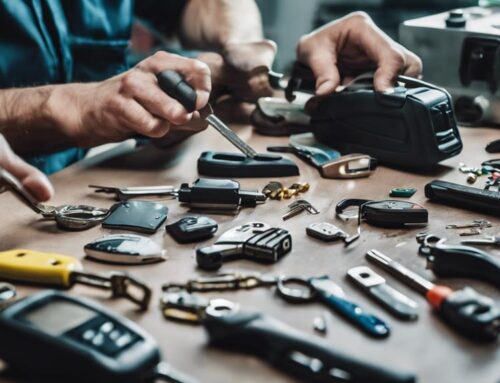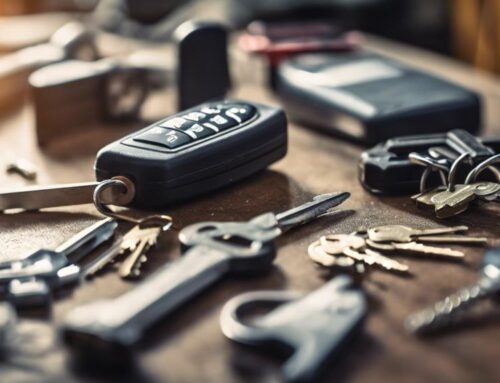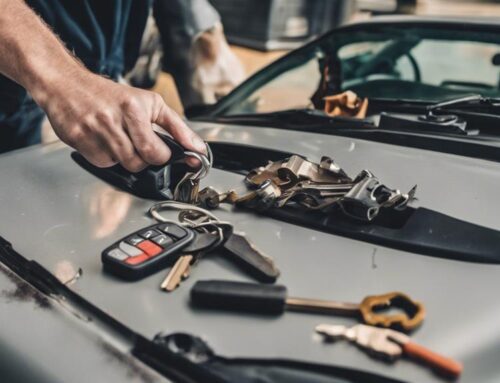If your key is hard to turn or the lock feels loose, it's time to address potential issues. Common signs like these indicate potential problems that could compromise your security. Pay attention to key alignment and lubrication to guarantee smooth operation. Loose screws or wobbly locks can be fixed by tightening or adjusting components. Key getting stuck signals debris buildup or misalignments, requiring cleaning and lubrication. Understanding common lock repairs like rekeying or lock cylinder replacement can help maintain functionality and enhance security. Stay informed about these repair types to keep your locks in prime condition for peace of mind.
Key Takeaways
- Difficulty turning the key indicates lock mechanism issues or misalignments.
- Loose or wobbly locks may result from loose screws or handle adjustments.
- Key getting stuck can be due to debris, worn-out keys, or rust.
- Regular maintenance prevents lock problems and enhances security.
- Common lock repairs include rekeying, cylinder replacement, and strike plate adjustments.
Signs Your Lock Needs Repair
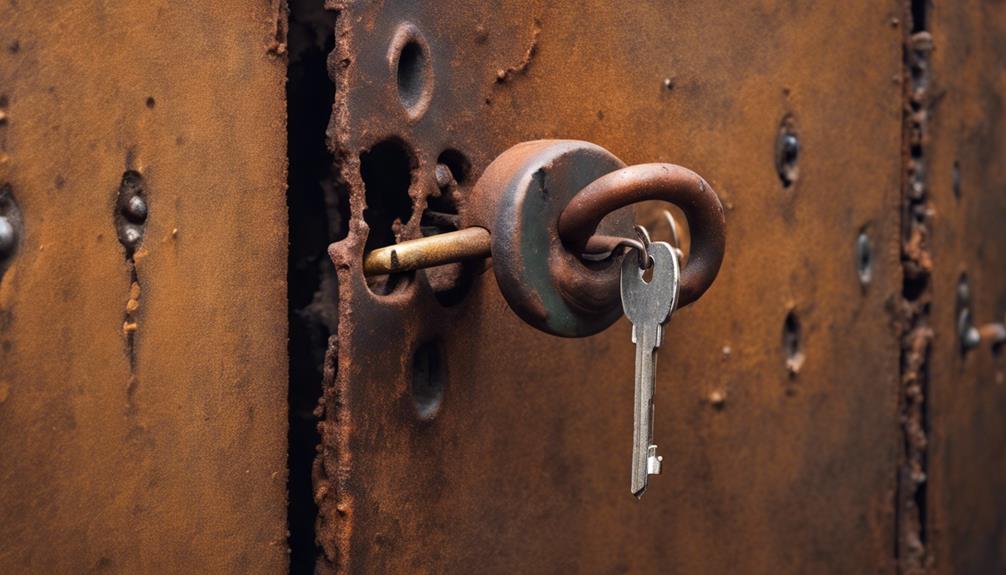
If you notice that your lock is becoming difficult to turn or insert the key into, it may be a sign that your lock needs repair. Locks can be temperamental creatures, needing their fair share of maintenance. Regular lock maintenance is key to ensuring your security remains exceptional. Neglecting your lock can lead to potential security vulnerabilities. To prevent any unwanted surprises, consider security upgrades if your lock is showing signs of wear and tear. Upgrading your lock can not only enhance your security but also provide peace of mind. Remember, a well-maintained lock is a happy lock, and a happy lock means a happy you! So, keep an eye out for any signals that your lock might need a little TLC.
Difficulty Turning the Key
Experiencing difficulty turning the key in your lock can be a frustrating situation that may indicate underlying issues with the lock mechanism. If you find yourself jiggling and struggling with the key more than usual, it could be due to key alignment problems or lack of proper lubrication. Key alignment refers to the way the key fits into the keyway of the lock. Misalignments can occur over time due to wear and tear, making it harder to turn the key smoothly. Additionally, lubrication issues, such as dried-up or gritty lubricants, can impede the key's movement within the lock cylinder. Ensuring proper key alignment and keeping the lock well-lubricated can help alleviate this annoyance.
Loose or Wobbly Lock
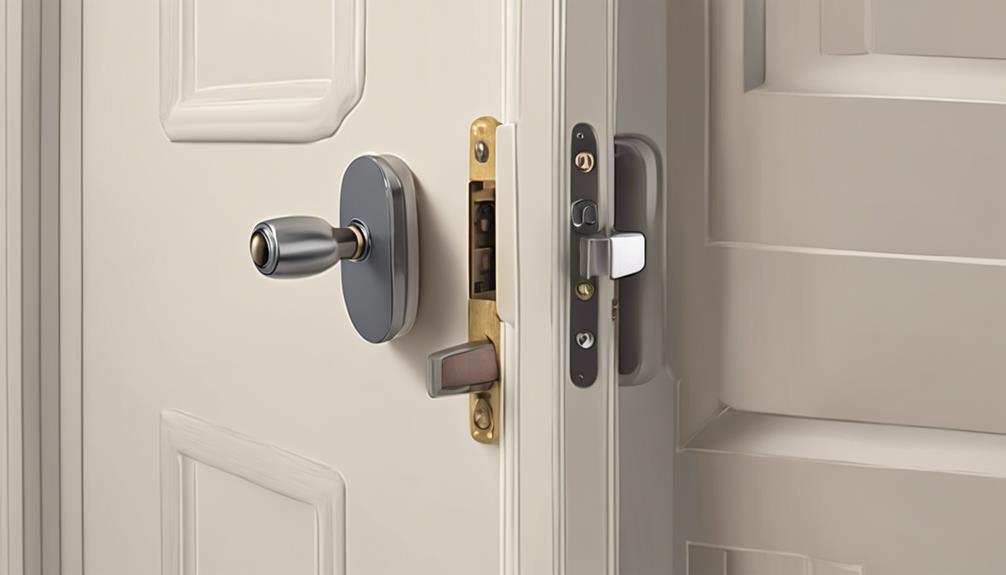
If you notice your lock feeling loose or wobbly, it may be due to screws that have come undone over time. To address this issue, tighten any loose screws that are causing the lock to feel unstable. Additionally, if the handle of the lock is wobbly, you can fix this by adjusting or replacing the handle to guarantee a secure fit.
Tightening Loose Screws
To address a loose or wobbly lock, the first step is to tighten any loose screws that may be causing the issue. Grab your trusty DIY tools, like a screwdriver, and get ready to channel your inner handyman (or handywoman)! Start by locating the screws on the lock plate and strike them with precision. Give each screw a gentle twist to the right to guarantee they are snugly in place. You don't want those sneaky screws causing your lock to misbehave! Remember, a secure lock is your first line of defense, so don't overlook this step. Once those screws are tightened, you'll feel like a security upgrades pro, ready to take on any wobbly lock challenge that comes your way!
Fixing Wobbly Handles
When dealing with a loose or wobbly lock, addressing the issue of fixing wobbly handles is essential to guarantee the security and functionality of your lock. A wobbly door handle can be quite frustrating but fear not, with the right repair tools and a touch of DIY spirit, you can tackle this issue like a pro. To fix a wobbly handle, start by unscrewing the handle and carefully inspecting the mounting screws and the handle mechanism. Tighten any loose screws using a screwdriver, making sure not to over-tighten. If the handle continues to wobble, you may need to replace the screws or even the entire handle mechanism. Remember, a stable door handle is not just a convenience but also a key to keeping your home secure.
Key Getting Stuck in the Lock
If you find your key getting stuck in the lock, several factors could be causing this issue. Worn-out keys or locks, debris buildup inside the lock, or misalignment of the lock mechanism are common culprits. To address a stuck key, consider cleaning out the lock, lubricating it with graphite powder, or seeking professional assistance for a more thorough inspection and repair.
Causes of Stuck Key
Experiencing a stuck key in your lock can be a frustrating inconvenience that may leave you feeling puzzled about its cause. Several factors can lead to a key getting stuck, including:
| Causes of Stuck Key | Description | Solution |
|---|---|---|
| Debris in the Lock | Dirt, dust, or small particles can accumulate in the lock, preventing the key from turning smoothly. | Clean the lock with compressed air or a small brush. |
| Worn Out Key | A key that is old or damaged may not align properly with the lock pins, causing it to get stuck. | Consider getting a new key cut by a locksmith. |
| Rust Build-Up | Moisture exposure can lead to rust formation inside the lock, hindering key movement. | Use a rust penetrant or lubricant to loosen the rust. |
Regular lock maintenance and key lubrication can help prevent these issues.
Solutions for Key Sticking
Wondering how to address a key that keeps getting stuck in your lock? If your key is sticking, first try lubricating it with a silicone-based spray or graphite powder. Apply the lubricant directly into the keyhole and insert the key a few times to spread it evenly. If lubrication doesn't work, the issue might be with the lock alignment. Check if the lock is properly aligned with the door frame; adjustments may be needed. Use a screwdriver to tighten loose screws or bolts on the lock mechanism. If the problem persists, consider seeking professional help to avoid damaging the lock further. Remember, a little key lubrication can go a long way in keeping your locks smooth and trouble-free!
Types of Common Lock Repairs
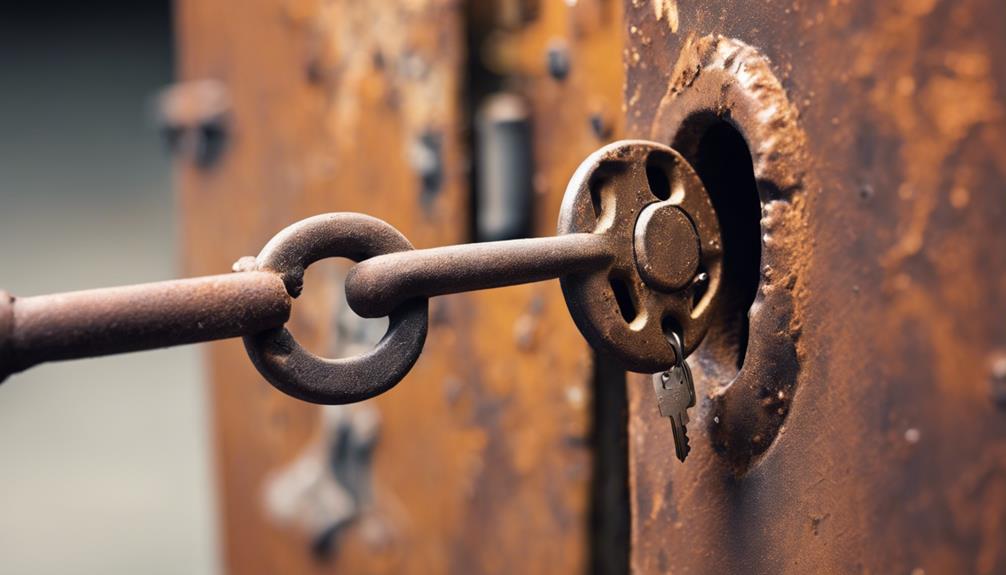
When it comes to common lock repairs, there are several types that you may encounter. One frequent issue is lock maintenance, where locks can become stiff or sticky over time due to dust and debris accumulation. Regular cleaning and lubrication can often solve this problem. Another common repair involves security upgrades, such as installing deadbolts or smart locks to enhance your home's safety. Sometimes, lock cylinders may need to be replaced if they are worn out or damaged. Additionally, adjusting the strike plate alignment can resolve issues with doors not locking properly. By staying on top of these maintenance tasks and upgrades, you can guarantee your locks are functioning smoothly and securely.
Rekeying
Rekeying a lock is a process that involves altering the lock's configuration so that it can be operated by a different key. When considering lock rekeying, keep in mind these vital details:
- Key Change: The existing key will no longer work once the lock is rekeyed.
- Enhanced Security: Rekeying provides security by preventing old keys from working. It is important to maintain home security by periodically rekeying locks to guarantee up-to-date protection.
- Cost-Effective: It is often cheaper to rekey a lock than to replace the entire lock.
- DIY Option: While a locksmith is recommended, some rekeying kits allow you to do it yourself.
Lock Cylinder Replacement
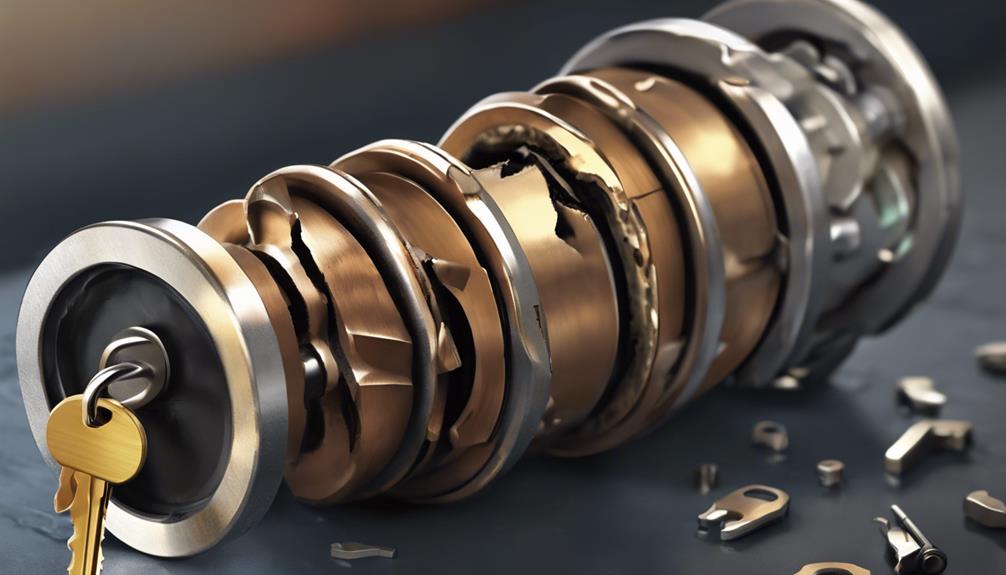
To replace a lock cylinder, you will need to first confirm that you have the necessary tools and replacement parts. Lock cylinder replacement is essential for lock maintenance and security upgrades. Begin by removing the screws on the lock's faceplate to access the cylinder. Insert the key and turn it slightly to align the cam with the rest of the lock. Once aligned, you can slide out the cylinder and replace it with a new one. Verify the new cylinder matches the brand and model of your current lock. Slide the new cylinder in, test it with the key, and reassemble the lock. This process can enhance security and give you peace of mind knowing your lock is in top condition.
Conclusion
In summary, being aware of the signs that your lock needs repair and understanding the common types of lock repairs can help you maintain the security of your property. By taking proactive steps and addressing any issues promptly, you can guarantee that your lock functions smoothly and effectively. Stay vigilant and prepared to tackle any lock-related challenges that may arise, so you can keep your property safe and secure.

